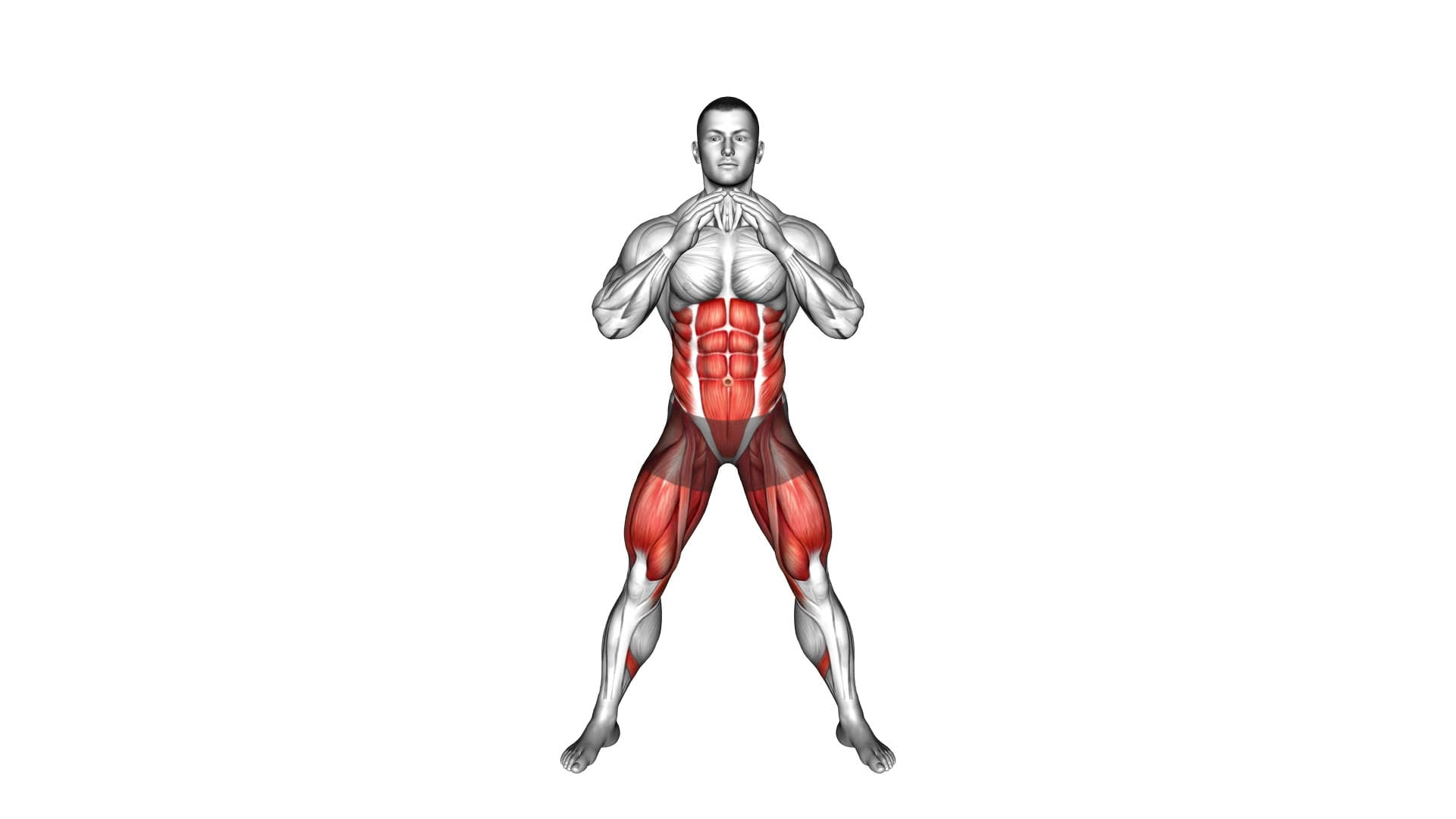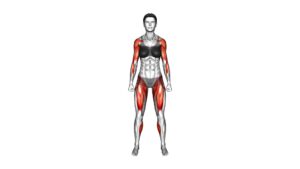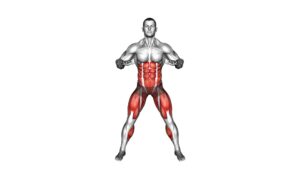Squat and Double Knee To Elbow (male) – Video Exercise Guide & Tips

Are you looking to strengthen your core and build lean muscle? Then the Squat and Double Knee to Elbow exercise is perfect for you.
Watch This Exercise Video
In this video exercise guide, we'll show you the proper form and technique to maximize your results. Whether you're a beginner or advanced, we have modifications and tips to suit your fitness level.
Avoid common mistakes and learn how to progress and increase intensity. Get ready to transform your workout routine with this challenging exercise.
Key Takeaways
- Compound movement targeting multiple muscle groups
- Strengthens lower body, particularly quadriceps, hamstrings, and glutes
- Works core muscles, including abs and obliques
- Versatile exercise that can be modified for different fitness levels and goals
Benefits of the Squat and Double Knee To Elbow Exercise
You will experience numerous benefits from incorporating the Squat and Double Knee To Elbow exercise into your workout routine.
This exercise is a compound movement that targets multiple muscle groups, making it an efficient way to build strength and increase overall fitness.
One of the main benefits of the Squat and Double Knee To Elbow exercise is its ability to strengthen your lower body, particularly your quadriceps, hamstrings, and glutes. By performing squats, you engage these muscles, promoting better balance and stability.
Additionally, the Double Knee To Elbow component of the exercise works your core muscles, including your abs and obliques. This not only helps to improve your overall core strength but also enhances your posture and stability.
Another benefit of this exercise is its versatility. It can be modified to suit different fitness levels and goals. Whether you're a beginner or an advanced athlete, you can adjust the intensity and difficulty of the exercise by adding weights or incorporating variations.
Proper Form and Technique for Maximum Results
To get the best results from the Squat and Double Knee To Elbow exercise, it's crucial to focus on your form and technique. Perfecting your form will ensure that you're targeting the right muscles and minimizing the risk of injury.
Pay attention to the points mentioned in this article to maximize your gains and see the desired results.
Form for Best Results
Proper form and technique are essential for maximizing results in the Squat and Double Knee To Elbow exercise. When performed correctly, this exercise can provide numerous benefits.
First, maintaining proper form helps to engage the targeted muscles effectively, such as the quadriceps, glutes, and core. This leads to improved strength, stability, and overall muscle development.
Additionally, using the correct technique reduces the risk of injury and ensures that the exercise is performed safely and efficiently. To improve your technique, focus on keeping your back straight, knees aligned with your toes, and engaging your core throughout the movement.
It's also helpful to start with lighter weights or no weights at all to perfect your form before adding resistance.
Perfecting Technique for Gains
Maintain optimal form and technique in order to achieve maximum gains in the Squat and Double Knee To Elbow exercise. Here are some key points to keep in mind:
- Importance of flexibility: Before starting the exercise, it's crucial to warm up and stretch your muscles properly. This will improve your range of motion and reduce the risk of injury.
- Muscle activation during the exercise: Focus on engaging your core muscles throughout the movement. This will help stabilize your body and enhance the effectiveness of the exercise.
- Proper squat form: Keep your feet shoulder-width apart, toes slightly turned out. Lower your body by bending at the knees and hips, keeping your chest up and your back straight. Aim to lower until your thighs are parallel to the ground.
- Double Knee To Elbow technique: From a standing position, lift one knee towards your chest while simultaneously bringing the opposite elbow towards the knee. Alternate sides and perform the movement in a controlled manner.
By following these guidelines, you can ensure that you're performing the Squat and Double Knee To Elbow exercise with proper form and technique, maximizing your gains.
Now, let's move on to discussing equipment and modifications for different fitness levels.
Equipment and Modifications for Different Fitness Levels
When it comes to adapting exercises for different fitness levels, it's important to consider the necessary modifications and equipment. Depending on your fitness level, you may need to adjust the intensity or difficulty of the exercise.
For beginners, using lighter weights or resistance bands can be helpful, while more advanced individuals may require heavier weights or additional equipment to challenge themselves.
Level Adaptations Necessary
To adapt this exercise for different fitness levels, you can use various modifications and equipment. Here are four ways to modify the squat and double knee to elbow exercise based on your abilities:
- Beginner level: If you're new to this exercise or have limited strength and flexibility, start by performing the squat with just bodyweight. For the double knee to elbow, perform the movement with slow and controlled motions, focusing on form rather than speed.
- Intermediate level: Incorporate dumbbells or kettlebells to add resistance and challenge your muscles further. Increase the speed and intensity of the double knee to elbow movement, aiming to touch your knees to your elbows with each repetition.
- Advanced level: Use a barbell or weighted vest to increase the resistance for the squat. For the double knee to elbow, perform the movement explosively, bringing your knees to your elbows with power and speed.
- Modification for limited mobility: If you have limited mobility, perform the squat using a stability ball against a wall. For the double knee to elbow, perform a seated knee to elbow exercise, bringing your knees towards your chest while seated on a chair or bench.
Remember to listen to your body and choose the modification that suits your fitness level.
Equipment for Varying Abilities
As you adapt the squat and double knee to elbow exercise for varying abilities, it's important to consider the equipment and modifications available to different fitness levels. Level modifications and equipment options can help individuals of all abilities to safely and effectively perform this exercise.
For beginners or those with limited mobility, using a stability ball can provide added support and stability during the squat and knee to elbow movements.
Resistance bands can also be used to provide assistance or resistance, depending on the individual's fitness level.
Advanced participants can incorporate weights or kettlebells to increase the intensity of the exercise.
Common Mistakes to Avoid During the Exercise
To ensure proper form and maximize the effectiveness of the Squat and Double Knee To Elbow exercise, it's important to be aware of common mistakes that you should avoid. These mistakes can hinder your progress and increase the risk of injury. Here are some common mistakes to watch out for:
- Poor squat form: One of the most common mistakes isn't maintaining proper form during the squat portion of the exercise. Make sure to keep your back straight, chest up, and knees aligned with your toes. Avoid rounding your back or letting your knees collapse inward.
- Lack of core engagement: Another mistake isn't engaging your core muscles throughout the exercise. Your core plays a crucial role in stabilizing your body and maintaining balance. Remember to tighten your abs and draw your belly button in towards your spine during the knee to elbow movement.
- Overextending the neck: Many people tend to strain their neck by pulling it forward during the exercise. This can lead to unnecessary tension and discomfort. Keep your neck in a neutral position and avoid excessive movement or straining.
- Rushing the exercise: Lastly, rushing through the exercise can compromise your form and reduce its effectiveness. Take your time and focus on performing each movement with control and precision.
Tips for Progression and Increasing Intensity
To progress and increase the intensity of the Squat and Double Knee To Elbow exercise, incorporate these tips into your routine.
- One technique is to increase the weight you're squatting. You can do this by using dumbbells or a barbell to add resistance to the squat movement.
- Another progression technique is to increase the number of repetitions or sets you perform. This will increase the overall volume of the exercise and help to build endurance.
- Additionally, you can try incorporating advanced variations of the exercise. For example, you can perform the Squat and Double Knee To Elbow exercise on an unstable surface, such as a Bosu ball or a balance disc. This will challenge your core stability and engage more muscles.
- You can also try performing the exercise at a slower tempo, focusing on controlling the movement and emphasizing the contraction of the muscles.
Sample Workout Routine Incorporating Squat and Double Knee To Elbow
Now that you've learned tips for progression and increasing intensity, how can you incorporate the Squat and Double Knee To Elbow exercise into a sample workout routine?
This exercise is a great addition to any full-body workout routine, as it targets multiple muscle groups and can be modified to suit different fitness levels.
Here's a sample workout routine that includes the Squat and Double Knee To Elbow exercise:
- Warm-up: Start with 5-10 minutes of light cardio to get your blood flowing and muscles warmed up.
- Squat and Double Knee To Elbow: Perform 3 sets of 10-12 reps of the Squat and Double Knee To Elbow exercise. Remember to maintain proper form and engage your core throughout the movement.
- Upper body strength training: Incorporate exercises like push-ups, dumbbell rows, and shoulder presses to target your chest, back, and shoulders.
- Lower body strength training: Include exercises like lunges, deadlifts, and leg presses to work your glutes, hamstrings, and quads.
By including the Squat and Double Knee To Elbow exercise in your workout routine, you can effectively target your lower body, core, and upper body muscles. Remember to listen to your body and adjust the intensity as needed.
Have fun and enjoy the benefits of this challenging exercise!
Frequently Asked Questions
Can I Do the Squat and Double Knee to Elbow Exercise if I Have Lower Back Pain?
If you have lower back pain, it's important to consider alternative exercises that won't aggravate your condition. Squat and Double Knee To Elbow exercise may put strain on your lower back, so it may not be suitable for you.
Instead, focus on exercises that strengthen your core and improve flexibility, such as planks or bird dogs.
Remember to consult with a healthcare professional or a trainer to find modifications that are safe and effective for your specific needs.
How Many Calories Can I Expect to Burn While Doing the Squat and Double Knee to Elbow Exercise?
When it comes to burning calories, the squat and double knee to elbow exercise can be quite effective. By engaging multiple muscle groups, this exercise can help you burn a significant amount of calories in a short period of time. However, it's important to note that the number of calories burned will vary based on factors such as your weight, intensity, and duration of the exercise.
To maximize calorie burn, focus on maintaining proper form throughout the exercise.
Is It Normal to Feel Soreness in My Abs the Day After Doing the Squat and Double Knee to Elbow Exercise?
Yes, it's normal to feel soreness in your abs the day after doing the squat and double knee to elbow exercise. This exercise targets your abdominal muscles, so it's common to experience some soreness as your muscles adapt and strengthen.
To minimize discomfort, make sure you're using proper form and technique during the exercise. If the soreness persists or becomes severe, it's always a good idea to consult with a healthcare professional.
Can I Perform the Squat and Double Knee to Elbow Exercise Without Any Equipment?
Yes, you can perform the squat and double knee to elbow exercise without any equipment. It's a bodyweight exercise that targets your abs, core, and lower body.
If you don't have access to a gym or equipment, this exercise is a great alternative to strengthen and tone those muscles.
Just remember to maintain proper form and engage your core throughout the movement for maximum effectiveness.
How Long Should I Rest Between Sets While Performing the Squat and Double Knee to Elbow Exercise?
To ensure proper form and avoid injury, it's important to rest between sets while performing the squat and double knee to elbow exercise. A good rule of thumb is to rest for about 30-60 seconds between each set.
This allows your muscles to recover and maintain proper technique throughout the exercise. Remember to listen to your body and adjust the rest duration as needed.
Conclusion
Incorporating the squat and double knee to elbow exercise into your workout routine can provide numerous benefits for your overall strength and fitness. By maintaining proper form and technique, you can maximize the results of this exercise.
Additionally, there are various equipment and modification options available to accommodate different fitness levels. Avoiding common mistakes and gradually increasing the intensity can help you progress and achieve your fitness goals.
Consider integrating this exercise into your workout routine for a challenging and effective full-body workout.

Author
Years ago, the spark of my life’s passion ignited in my mind the moment I stepped into the local gym for the first time. The inaugural bead of perspiration, the initial endeavor, the very first surge of endorphins, and a sense of pride that washed over me post-workout marked the beginning of my deep-seated interest in strength sports, fitness, and sports nutrition. This very curiosity blossomed rapidly into a profound fascination, propelling me to earn a Master’s degree in Physical Education from the Academy of Physical Education in Krakow, followed by a Sports Manager diploma from the Jagiellonian University. My journey of growth led me to gain more specialized qualifications, such as being a certified personal trainer with a focus on sports dietetics, a lifeguard, and an instructor for wellness and corrective gymnastics. Theoretical knowledge paired seamlessly with practical experience, reinforcing my belief that the transformation of individuals under my guidance was also a reflection of my personal growth. This belief holds true even today. Each day, I strive to push the boundaries and explore new realms. These realms gently elevate me to greater heights. The unique combination of passion for my field and the continuous quest for growth fuels my drive to break new ground.







